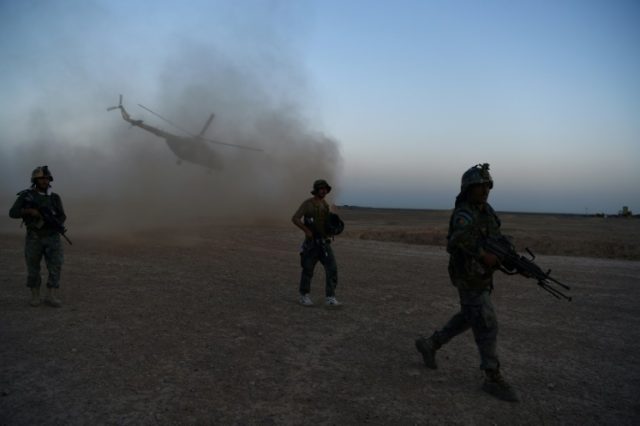The U.S. military has suspended airstrikes targeting the Taliban in Afghanistan while intensifying its air campaign against the Islamic State (ISIS/ISIL) wing in the country, which has already attempted to officially establish a “caliphate” twice this year alone, an American commander told reporters this week.
Taliban terrorists publicly rejected Afghan President Ashraf Ghani’s offer to extend a three-day ceasefire, embraced by both warring parties during the end of the Muslim holy month of Ramadan (June 15 through June 17).
Nevertheless, the U.S.-NATO coalition and their Afghan allies have decided to honor the truce and not attack the Taliban unless it is in self-defense, Brig. Gen. Lance R. Bunch, the top U.S. air commander in Afghanistan, told Pentagon reporters on Wednesday.
The U.S. military is intensifying the already historic number of American military airstrikes against the ISIS-K (the Afghan offshoot of the Islamic State of Iraq and Syria, called Islamic State-Khorasan province) amid Kabul’s unilateral ceasefire, the top general said.
Gen. Bunch said the suspension of offensive air attacks against the Taliban came in response to the unilateral ceasefire against the terrorists that began June 11 at the behest of Kabul.
He emphasized that the pause in hostilities is the first unilateral truce since the war began in October 2001, nearly 17 years ago.
During the ongoing pause in anti-Taliban strikes, U.S. troops “are continuing to both train the Afghan Air Force, whether they be maintainers or do training flights with their pilots, and continue to do things that continue to build the air force and take advantage of this time,” Bunch explained.
“We continue to fly our aircraft in sorties for intelligence and keep situational awareness on the entire battlefield so that we see where the Taliban are potentially moving … if the cease-fire does end, then we’ll look to take advantage of the information we gathered during this time,” he added, noting that the U.S. military maintains its ability to respond to an attack in self-defense.
The general argued that military pressure “coupled with diplomatic and social pressure” under U.S. President Donald Trump’s South Asia strategy has triggered the truce and talks of ending the war.
Gen. Bunch said:
The military pressure we’ve been putting on the Taliban [has been] … a contributing factor to the recent cease-fire; that we’re still under, by the way … the cease-fire and more talk of peace are clear indications the South Asia Strategy is working. … The opportunity for the Taliban to come to the table and look to reconcile is now, because their offensive operations have proven a few things: They cannot hold ground, and they are taking lots of casualties all of which is not a winning strategy.
Gen. Bunch stressed that the truce does not cover the ISIS wing in Afghanistan known as the Khorasan Province (ISIS-K).
“We have conducted strikes against ISIS-K during this [ceasefire] timeframe … a little over 80 of those strikes, as we continue to do counterterrorism operations against ISIS-K, who is not part of the cease-fire,” Bunch explained.
The U.S. military has intensified operations against ISIS with “the single largest deployment of” Afghan “commandos on the battlefield ever” charged with developing intelligence identifying targets, and calling airstrikes, including the recent estimated 80 against the Islamic State “without the aid of United States.”
Amid the unilateral ceasefire, the U.S. military is intensifying its the already historic number of airstrikes against the ISIS-K, the top general said.
“There had been a slight increase. … We have increased our operations against ISIS-K,” the commander said.
Kabul deployed the Afghan commandos in support of an offensive to prevent ISIS-K from officially establishing a territorial “caliphate” in eastern Afghanistan’s Nangarhar province stronghold, according to the general.
“They were able to dislodge ISIS-K from there,” Gen. Bunch said, referring to the Afghan troops participating in the Nangarhar offensive, adding:
Just the beginning of this month, the Afghan Special Forces put four companies of commandos on the ground in [Nangarhar’s] Gurgoray and Deh Bala, which was where ISIS-K is trying to establish their caliphate. This is the second time this year that they’ve tried to establish their caliphate … Some of these 84 or 80-something strikes were in support of those operations. And, of course, ISIS-K was unable to establish a caliphate there.”
Although the general acknowledged that the Afghan Air Force had conducted self-defense strikes 38 times since the unilateral ceasefire started on June 11, he maintained that the truce is holding.
“We’ve conducted no strikes [during unilateral ceasefire] because the Afghan Air Force has been so agile to support their own forces, Gen. Bunch declared.
U.S. President Trump’s strategy to end the Afghan war is primarily focused on achieving reconciliation between Kabul and the Taliban, American officials have stressed.
“The entire purpose behind our air campaign is to pressure the Taliban into reconciliation and help them realize that peace talks are their best option. We kept the pressure on them through the winter and into this spring. Before the recent cease-fire began, Operation Iron Tempest, the name of our air campaign, had destroyed 154 Taliban targets,” Gen. Bunch told reporters.

COMMENTS
Please let us know if you're having issues with commenting.